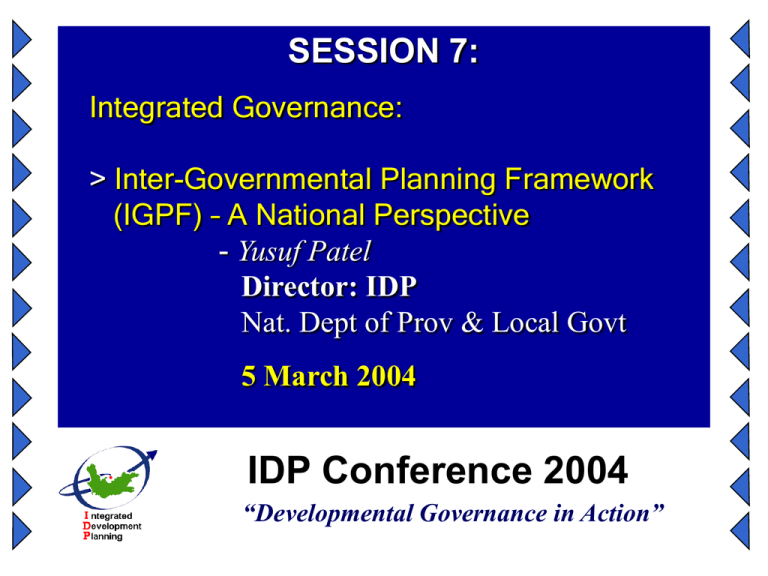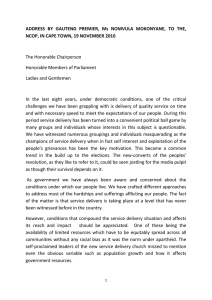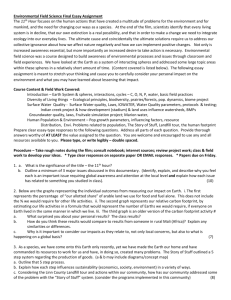A Protocol on Intergovernmental Planning
advertisement

SESSION 7: Integrated Governance: > Inter-Governmental Planning Framework (IGPF) – A National Perspective - Yusuf Patel Director: IDP Nat. Dept of Prov & Local Govt 5 March 2004 IDP Conference 2004 “Developmental Governance in Action” CONTENT 1. Background 2. Components of IGPF 3. Conclusion 2 1. Background • The “Developmental State”, the second economy and the power of the State • One Government, three spheres, same problems, common solution • Lack of intergovernmental – coordination in & between planning systems – alignment in the contents of plans – coordination in implementation • Cabinet decision on IGPF 3 Planning Spheres & Systems Current Situation Economic Dev Education Tourism Water Health Land NSDP Econ Socia l JCPS GSA SECTOR S i.e.: Provincial INT National CABINET CLUSTERS Unintegrated Local CROSS CUTTING ISSUES i.e.: PGDS IDP Lack of alignment & cooperation HIV/AIDS Poverty MTSF District Metro. Space MTEF & Budget MTEF & Budget Safety& Securtity LED Environment Disaster Manegement Fin. Plans & Budget DEPARTMENTAL STRATEGIC PLANS Un-integrated, ineffective & insufficient infrastructure investment & development spending 4 2. Components of IGPF Relevant Government Planning Systems A Protocol 1. Code of Conduct • Regarding appropriate behaviour in and between spheres and planning systems 2. Intergovernmental Development Agreements (IDeAs) 3. Strategic Diary 5 Relevant Government Planning Systems • Executive and Integrated Development Planning (All spheres) • Financial Planning & Budgeting (All spheres) • Sector and Crosscutting IssuePlanning (All spheres) • Departmental Strategic Planning (Provincial and National) 6 Relevant Government Planning Systems (cont) • Executive Integrated Development Plans & Planning Cycles National MTSF •Country development strategy •Provides strategic direction for development on national, provincial & local level •Focuses on key triggers for economic growth and development •Cements national development vision NSDP •Guides infrastructure investment & development spending in all spheres •Informs MTSF, PGDSs, IDPs & sector plans 7 Relevant Government Planning Systems (cont) • Executive and Integrated Development Plans & Planning Cycles Provincial PGDS •Sets out provincial development strategy •Guides investment in province •Provides strategic framework for local level planning •Aligns national, provincial and local priorities Local IDP •Provides strategic direction for local development & municipal functioning •Contextualises national & provincial objectives •Provides arena for dialogue on development between various spheres of government and communities •Enables integrated service delivery & infrastructure investment (between spheres & systems) 8 Relevant Government Planning Systems (cont) • Financial Plans National MTEF Provincial MTEF Local 3 Year Financial Plan MTEF & Budgets • Maps income and programmes expenditure of resources • Links financial planning to annual budgets & budget cycles • Based on integrated development planning and plans • Reflects and guides development plans, sector plans & departmental strategic plans 9 Relevant Government Planning Systems (cont) • Sector and Crosscutting issuePlans & Planning Processes INTEGRATED SECTOR PLANNING (all spheres): Transport Housing Economic Dev Education Tourism Water Health Land SECTOR S i.e.: CROSS CUTTING ISSUES i.e.: HIV/AIDS Poverty Safety & Securtity LED Environment Disaster Manegement 10 Relevant Government Planning Systems (cont) • Departmental Strategic Plans, Planning Processes & Budgets in all spheres: • Institutional planning • Resource allocation (Financial, Human Resources, etc.) • Proposed infrastructure investment and development spending • Performance management • Gives effect to priorities & proposals in the MTSF, PGDSs and IDPs DEPARTMENTAL STRATEGIC PLANS 11 INTERGOVERNMENTAL PLANNING SYSTEM Econ Socia l JCPS GSA INT National CABINET CLUSTERS MTSF INTEGRATED SECTOR PLANNING NSDP HIV/AIDS Poverty Economic Dev Education Tourism Water Health IDP Land Local CROSS CUTTING ISSUES i.e.: PGDS SECTOR S i.e.: Provincial MTEF & Budget District/ Metro. Space MTEF & Budget Safety& Securtity LED Environment Disaster Manegement Fin. Plans & Budget Links Intergov. Impact 12 2. Components of IGPF Relevant Government Planning Systems A Protocol 1. Code of Conduct • Regarding appropriate behaviour in and between spheres and planning systems 2. Intergovernmental Development Agreements (IDeAs) 3. Strategic Diary 13 1. Code of Conduct • To ensure greater coherence and consistency in and between the three spheres in their development, sector, financial and departmental planning and budgeting, all role players must: – Align proposals for infrastructure investment and development spending as captured in development, sector, departmental and financial plans in time and space; – Participate and collaborate with colleagues within and between the different spheres of government in their respective development and sector plan preparation and review processes; – Adhere to national development objectives, development principles, policy positions and legal provisions & requirements in all planning actions; – Link the proposals captured in development, sector and departmental planning and plans with financial 14 planning and plans; 1. Code of Conduct – Coordinate and integrate the implementation of proposals captured in development plans with programmes and projects in sector, departmental and financial plans; – Establish agreements (IDeAs) with participating role players and set up structures and mechanisms within and between spheres and sectors to support the required actions; – Share planning, project and programme information in the right format and at the right time by making use of the IDP Nerve Centre; – Rigorously monitor and review development objectives and outcomes of the programmes and projects for implementation (as set out in IDeAs); and – Take strong corrective measures as and where necessary. 15 2. Intergovernmental Development Agreements (IDeAs) One set of agreements: – Drawn up by: municipalities and organs of state in the provincial and national spheres – On: infrastructure investment & development spending approach, commitments, targets, indicators – For: each district & metro municipality (a specific spatial area) – Will: ensure greater predicatability, commitment and enable “intergovernmental performance management” 16 2. Intergovernmental Development Agreements (IDeAs) (continued…) • Signed into operation by: relevant Premiers, Mayors and Ministers • Prepared: during preparation of IDPs and PGDSs • Based on and informs: subsequent preparation and reviews of IDPs & PGDSs • Captured in: IDP Nerve Centre where progress on reaching commitment, signing off and implementation can be monitored electronically 17 2. Intergovernmental Development Agreements (IDeAs) (continued…) • Templates on IDP Nerve Centre will ensure: commitment to national development objectives, adherence to NSDP principles, integration and standardisation for ease of use • Initially: Agreements may not contain any immediate commitment to infrastructure investment or development spending • Agreements will over time: ensure a progression towards actual expenditure & will strengthen intergovernmental relations 18 3. Strategic Diary • Specifies dates for completion of key activities in each of the government planning systems and spheres • Enables: – Alignment in planning, – Cooperation and integration in infrastructure investment and development spending – Realisation of Intergovernmental Development Agreements (IDeAs) 19 3. Conclusion Through developmental focused MTSF and the Protocol government will: • act as one entity; • focus on key national priorities; • deliver services and channel resources in the most effective way; and • assist in the eradication of the dualitistic nature of the South African economy. •Executive and Integrated Development Planning •Financial Planning •Sector and Crosscutting issue-Planning •Departmental Strategic Planning 20



